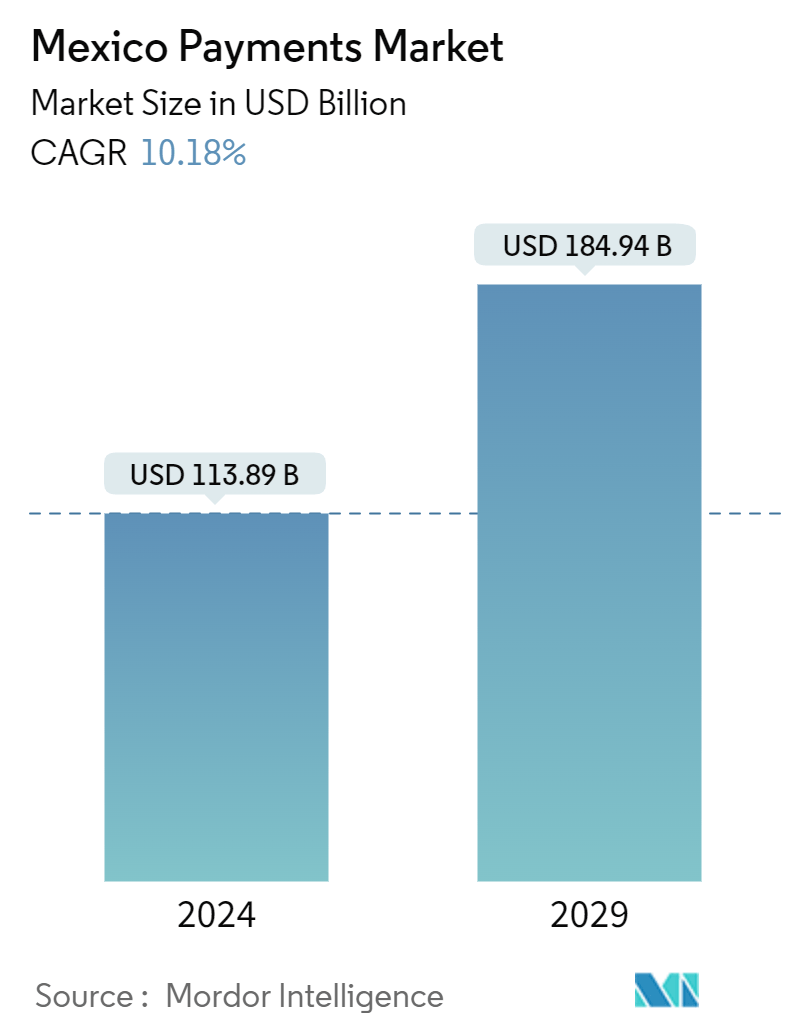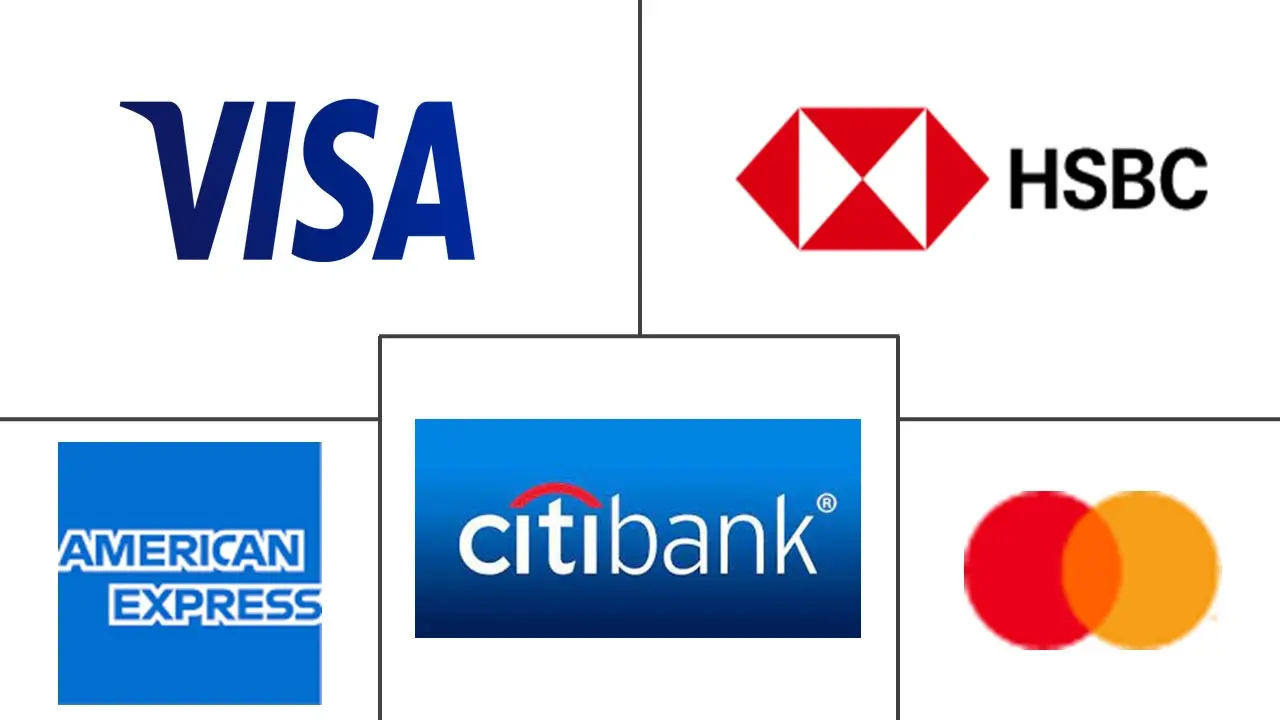Market Size of Mexico Payments Industry

| Study Period | 2019 - 2029 |
| Base Year For Estimation | 2023 |
| Market Size (2024) | USD 113.89 Billion |
| Market Size (2029) | USD 184.94 Billion |
| CAGR (2024 - 2029) | 10.18 % |
| Market Concentration | Medium |
Major Players
*Disclaimer: Major Players sorted in no particular order |
Mexico Payments Market Analysis
The Mexico Payments Market size is estimated at USD 113.89 billion in 2024, and is expected to reach USD 184.94 billion by 2029, growing at a CAGR of 10.18% during the forecast period (2024-2029).
- The payment methods market is growing due to increased digitalization. The growing popularity of smartphones and the widespread availability of internet connectivity are driving up demand for mobile payment transactions. Similarly, government measures encourage customers to use contactless payment platforms. Furthermore, integrating technology such as artificial intelligence and machine learning is anticipated to improve the security system, increasing consumer trust in payment systems.
- The market studied is expected to be driven by government policies. For example, the Ministry of Finance constructed its IT system to authorize and process government payments after developing the legal foundation to enable centralized payments. Furthermore, the Central Bank created a nationwide payment system to allow for the quick and inexpensive movement of funds to any bank account in the country.
- Furthermore, the presidential administration has encouraged the use of digital payments and a reduction in the use of cash to foster financial inclusion in Mexico. Mexican authorities define financial inclusion as accessing and utilizing formal and appropriately regulated financial services that guarantee consumer protection rights and develop financial literacy.
- The growth of digital payments drives the Mexican payment market. With the rapid advancement of technology and changing consumer preferences, digital payments have become increasingly popular and widespread across the country.
- Increasing internet penetration drives the Mexican payment market. As more people gain internet access, they increasingly engage in online activities, including shopping, banking, and making payments. The Mexican government has been promoting digital payments and financial inclusion as part of its broader economic agenda.
- Cybercriminals often use phishing emails, fake websites, and social engineering tactics to trick users into disclosing their login credentials or financial information. The prevalence of phishing scams can undermine confidence in digital payment platforms and discourage users from engaging in online transactions.
- Since the outbreak of the COVID-19 pandemic, the demand for digital payments has increased exponentially in the country, owing to the growing demand for contactless payment methods. Even though QR code payments see prominent adoption and growth in Mexico, the demand is expected to increase worldwide primarily because they are easy and inexpensive to implement. Post-COVID-19 pandemic, the market is proliferating due to convenience, which is one of the main reasons for Mexicans' quick acceptance of digital payments. The convenience and security of using a digital payment method have increased the number of Mexicans using digital payments.
Mexico Payments Industry Segmentation
Payments are becoming increasingly cashless, and the industry's responsibility to support inclusivity has risen to the top of the agenda. Payments help promote digital economies and encourage innovation while also providing a reliable backbone for the global economy. POS and e-commerce are the two segments of the payments market. Online purchases of both products and services, such as purchases made on e-commerce websites and online travel and hotel bookings, are examples of e-commerce payments. All transactions taking place at a physical point of sale are included in the market's scope when it comes to POS.
The Mexican payments market is segmented by mode of payment (point of sale [card payments, digital wallet, cash, and other points of sale] and online sale [card payments, digital wallets, and other online sales]) and end-user industry (retail, entertainment, healthcare, hospitality, and other end-user industries). The market sizes and forecasts are provided in terms of value (USD) for all the above segments.
| By Mode of Payment | ||||||
| ||||||
|
| By End-user Industry | |
| Retail | |
| Entertainment | |
| Healthcare | |
| Hospitality | |
| Other End-user Industries |
Mexico Payments Market Size Summary
The Mexico payments market is experiencing significant growth, driven by increased digitalization and the widespread adoption of smartphones and internet connectivity. This shift is fostering a rise in mobile payment transactions and encouraging the use of contactless payment platforms, supported by government initiatives. The integration of advanced technologies like artificial intelligence and machine learning is enhancing security, thereby boosting consumer confidence in digital payment systems. Government policies play a crucial role in this expansion, with efforts to centralize payments and promote financial inclusion through digital means. The COVID-19 pandemic has further accelerated the adoption of digital payments, as consumers seek convenient and contactless transaction methods. This trend is evident in the growing popularity of QR code payments and the increased use of card payments for online sales, which have been bolstered by strategic collaborations among market players.
The hospitality and travel sectors in Mexico are also contributing to the growth of the payments market, as digital payment solutions become integral to enhancing customer experiences. The demand for seamless and integrated payment options is rising, driven by the need for convenience in hotel check-ins and online bookings. The market is characterized by the presence of major players like Visa, Mastercard, and American Express, who are actively engaging in partnerships and acquisitions to strengthen their market position. Innovations such as buy now pay later (BNPL) solutions are being introduced to cater to evolving consumer preferences. The market's semi-consolidated nature allows for competitive dynamics, with companies like NovoPayment and Western Union expanding their offerings to support cross-border transactions and flexible payment solutions. Overall, the Mexican payments market is poised for continued growth, supported by technological advancements and strategic collaborations.
Mexico Payments Market Size - Table of Contents
-
1. MARKET INSIGHTS
-
1.1 Market Overview
-
1.2 Industry Stakeholder Analysis
-
1.3 Industry Attractiveness - Porter's Five Forces Analysis
-
1.3.1 Bargaining Power of Suppliers
-
1.3.2 Bargaining Power of Buyers/Consumers
-
1.3.3 Threat of New Entrants
-
1.3.4 Threat of Substitute Products
-
1.3.5 Intensity of Competitive Rivalry
-
-
1.4 Evolution of the payments landscape in the country
-
1.5 Key Market Trends Pertaining to the Growth of Cashless Transaction in the Country
-
1.6 Impact of COVID-19 on the payments market in the country
-
-
2. MARKET SEGMENTATION
-
2.1 By Mode of Payment
-
2.1.1 Point of Sale
-
2.1.1.1 Card Payments (includes Debit Cards, Credit Cards, Bank Financing Prepaid Cards)
-
2.1.1.2 Digital Wallet (includes Mobile Wallets)
-
2.1.1.3 Cash
-
2.1.1.4 Other Points of Sale
-
-
2.1.2 Online Sale
-
2.1.2.1 Card Payments (includes Debit Cards, Credit Cards, Bank Financing Prepaid Cards)
-
2.1.2.2 Digital Wallet (includes Mobile Wallets)
-
2.1.2.3 Other Online Sales (includes Cash on Delivery, Bank Transfer, and Buy Now, Pay Later)
-
-
-
2.2 By End-user Industry
-
2.2.1 Retail
-
2.2.2 Entertainment
-
2.2.3 Healthcare
-
2.2.4 Hospitality
-
2.2.5 Other End-user Industries
-
-
Mexico Payments Market Size FAQs
How big is the Mexico Payments Market?
The Mexico Payments Market size is expected to reach USD 113.89 billion in 2024 and grow at a CAGR of 10.18% to reach USD 184.94 billion by 2029.
What is the current Mexico Payments Market size?
In 2024, the Mexico Payments Market size is expected to reach USD 113.89 billion.

